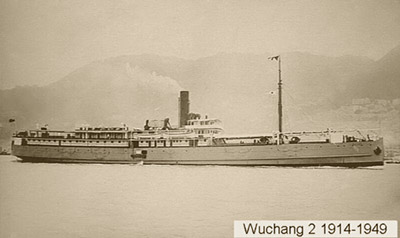The Luck of the Wuchang.
When I saw the rppc “After a perfect run” I was very struck, not only by the image, but also by the title.
Torpedoes - if that is what is being winched in here, do not usually get retreived - especially if the run for which they were designed has been perfect. And although the image is from another ocean and another time (from a series of postcards of the USS Georgia in 1915 sailing from Boston to Cuba) it made me think of the experiences my father Basil Gordon Phillips (1913 - 2004) had in 1942 whilst escaping the Japanese invasion of Malaya . . .
The Wuchang.
The Wuchang was a vessel designed for the river trade on the Yangtze and at the oubreak of war it was requisitioned by the British and sent to Singapore where it was painted bright orange and used to store bombs and munitions in a suitably remote part of Keppel Harbour.
At the fall of Singapore in February 1942 the Wuchang was brought back into service as a means of escape and sailed to Sumatra. Here it picked up a further number of fleeing British, including BGP who, setting off from Henrietta Estate in Kedah, had made it across the Straits of Malacca. The ship headed for Colombo.
On the 4th March it came under attack from a Japanese submarine - 3 torpedoes were fired, one missed but two, on target, were seen approaching. Although BGP did not witness this he was watching a man who clearly had - he'd turned instantly sheet white; they were in the middle of the Indian Ocean and there were no life boats on board. Luckily the Wuchang, built for river traffic, had a very shallow draft and the torpedoes passed clean under the hull. The Japanese submarine surfaced, no doubt mystified, but without other weaponary to deploy, dived and departed. 4 days later the Wuchang arrived in Columbo.
Operation Humour. Gemas
In Ceylon BGP volunteered to join SOE / Force 136. This organised small units of men to be dropped into enemy held areas and link up with local guerilla / resistance forces.
For his first mission he was parachuted into Burma: code named 'Operation Spiers'. At some point the group was compromised and they had to escape into China. At Kunming he was able to get the USAF to fly him back to India.
In the summer of 1945 he was again parachuted ('Operation Humour') into Japanese held territory in Negri Sembilan, Malaya. The party included BGP, liason officer to the MPAJA (Malayan People's Anti-Japanese Army), Olly Olson, a fellow planter, as well as two Chinese wireless operators: Pang Hoi and Chaing Cheok Sun.
At the Japanese surrender the group moved from their jungle camp into a disused saw mill in Gemas. At this time BGP (middle photo above) took the photos now in my possession including several of the 2 young Chinese w/t operators - one of which of Pang Hoi (right in photo on left, centre in photo on right) I used in 1977 for the watercolour featured in this work.
Next to slightly later reprints of these rolls of film BGP noted information relating to the people he had been working alongside in the MPAJA - this would have been at the time of the subsequent communist insurgency in Malaya known as the ‘Emergency’. One of the photos (right) notes PH and CCS "the W/T operators who dropped in with me. Now in China".
Back
